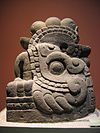Centzon Totochtin
- Centzon Totochtin
-
Centzon Totochtin, (appelés aussi Centzontotochtin dans la mythologie aztèque), sont les 400 dieux de l'ivresse[1]. Selon quelques sources, les centzon-totochtin étaient les fils des deux Mayahuel et Patecatl[2].
Selon divers auteurs les principaux étaient : Mayahuel (la mère avec Patecatl des Centzontotochtin selon certaines sources),Patecatl (le père avec Mayahuel des Centzontotochtin selon certaines sources), Tezcatzoncatl (le père des Centzontotochtin selon certaines sources), Tepoztecatl, Papaztac, Colhuacatzincatl, Totoltecatl[3], Yauhtecatl, Toltecatl[4], Izquitecatl, Tlilhua, Tlaltecayohua[5]
Autant d'autres sont Acolhua, Chimalpanecatl, Izquitecatl, Tequechmecauiani, Tzoaca, Ometochtli[6], Quatlapanqui, Yauhtecatl.
Notes et références
- ↑ (es) Cecilio Agustín Robelo, Diccionario de Mitología Nahua, México, Biblioteca Porrua. Imprenta del Museo Nacional de Arqueología, Historia y Etnología, 1905, 73 p. (ISBN 978-9684327955), p. Entre esos cuatrocientos dioses los autores mencionan como los principales á los siguientes: una mujer, Mayahuel y trece hombres...
- ↑ (es) Adela Fernández, Dioses Prehispánicos de México, México, Panorama Editorial, 1998, 138 p. (ISBN 968-38-0306-7), p. Mayahuel, "la diosa de las 400 tetas" alimenta a sus hijos los Centzontotochin...
- ↑ Appelé aussi Totoltecatl
- ↑ Appelé aussi Tultecatl
- ↑ Appelé aussi Tlaltecoyohua
- ↑ Appelé aussi Umetuchtli
Catégories :
- Divinité aztèque
- Groupes de divinités dans la mythologie aztèque
- Liste en rapport avec la mythologie aztèque
- Divinité aztèque chthonienne
Wikimedia Foundation.
2010.
Contenu soumis à la licence CC-BY-SA. Source : Article Centzon Totochtin de Wikipédia en français (auteurs)
Regardez d'autres dictionnaires:
Centzon Totochtin — In Aztec mythology, the Centzon Totochtin ( four hundred rabbits ; also Centzontotochtin) are a group of deities who meet for frequent parties; they are divine rabbits, and the gods of drunkenness. Some of their named members include Tepoztecatl … Wikipedia
Mitología mexica — Huitzilopōchtli colibrí del sur , dios de la guerra y el sol, dios nacional de los aztecas. La mitología mexica es una extensión del complejo cultural. Antes de llegar los aztecas al valle del Anáhuac, ya existían antiguos cultos y diosas del sol … Wikipedia Español
Aztec mythology — The Aztec civilization recognized a polytheistic mythology, which contained the many gods (over 100) and supernatural creatures from their religious beliefs. History Aztec culture is generally grouped with the cultural complex known as the Nahua… … Wikipedia
Aztec religion — is a Mesoamerican religion combining elements of polytheism, shamanism and animism within a framework of astronomy and calendrics. Like other Mesoamerican religion, it had elements of human sacrifice in connection with a large number of religious … Wikipedia
Ergo Proxy — エルゴプラクシー (Erugo Purakshī) Género Cyberpunk, Misterio, Suspenso Manga Ergo Proxy: Centzon Hitchers and Undertaker Creado por Yumiko Harao … Wikipedia Español
Macuiltochtli — ( Five Rabbit ; from Nahuatl, macuilli , five, tochtli , rabbit) is one of the five deities from Aztec and other central Mexican pre Columbian mythological traditions who, known collectively as the Ahuiateteo, symbolized excess, over indulgence… … Wikipedia
Macuiltochtli — Macuil Tochtli (El Cinco Conejo) o Macuiltochtli (del nah., macuilli, cinco, tochtli, conejo) era un dios mexica de la borrachera, venerado bajo la forma de un conejo. En el simbolismo religioso azteca los conejos se asociaban a la ebriedad y el… … Wikipedia Español
Мифология ацтеков — Содержание 1 Пантеон ацтекских богов 1.1 А 1.2 В 1.3 И 1.4 К … Википедия
pre-Columbian civilizations — Introduction the aboriginal American Indian (Mesoamerican Indian) cultures that evolved in Meso America (part of Mexico and Central America) and the Andean region (western South America) prior to Spanish exploration and conquest in the 16th … Universalium
Rabbit — Environmental problemsRabbits have been a source of environmental problems when introduced into the wild by humans. As a result of their appetites, and the rate at which they breed, wild rabbit depredation can be problematic for agriculture.… … Wikipedia

